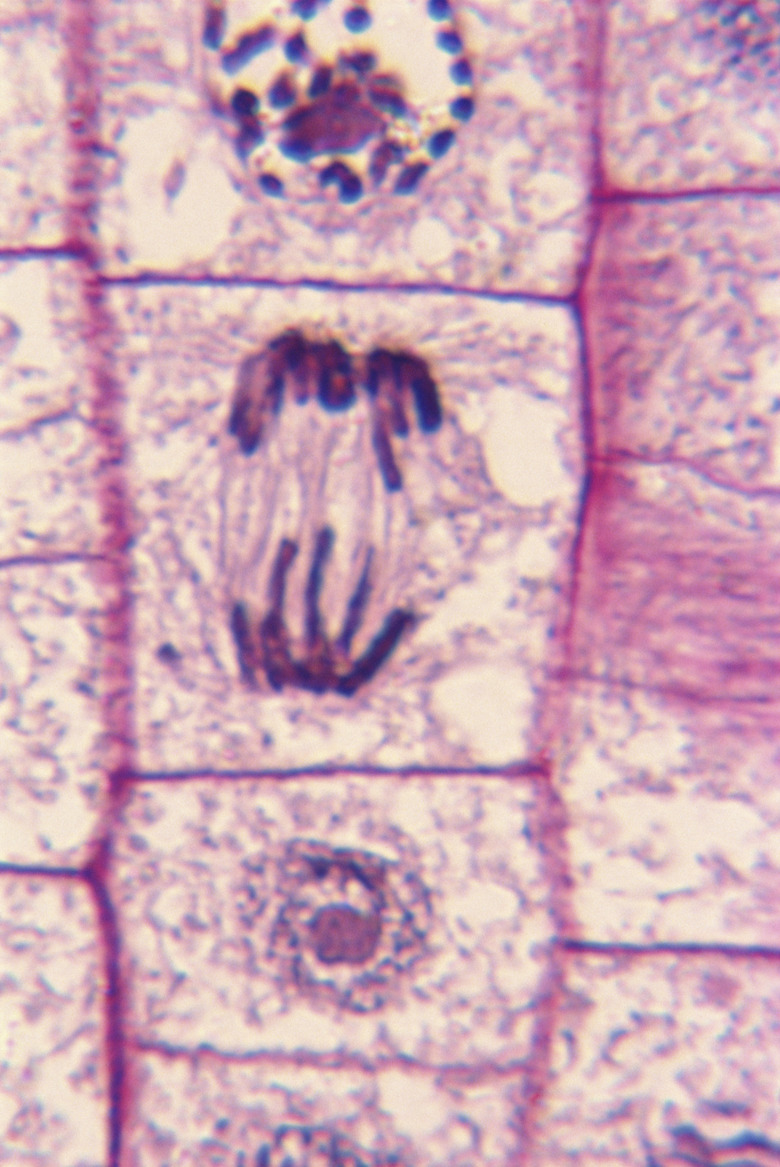What Is The Difference Between A Centriole & A Centrosome?
Each animal cell has two centrioles located within a centrosome. Both centrioles and centrosomes are complicated cell structures that are essential for cell division. The centrosome directs the movements of the chromosomes when a cell divides, and the centrioles help create the spindle of threads along which the duplicated chromosomes separate into the two new cells. The intricate structure of these cell organelles and the details of how they work gives an idea of the complex and finely tuned functioning of living cell division.
TL;DR (Too Long; Didn't Read)
Chromosome migration in animal cell division is governed by the centrosome found near the nucleus of each cell. Two centrioles surrounded by a mass of material containing about 100 different proteins are located inside each centrosome. Centrioles are tiny organelles made up of nine symmetrically arranged microtubules, each of which has two partial tubules attached to it. During cell division, the centrosome directs the migration of chromosomes while the tubules of the centrioles help create a network of threads across the cell. In the final stages of cell division, the duplicate chromosomes separate and travel along the threads to opposite ends of the cell nucleus.
The Difference Between Centrosome and Centriole
The Difference Between Centrosome and Centriole
While both are necessary for a cell to divide into two new identical cells, a centrosome is an amorphous structure containing two centrioles while a centriole is an organelle with an intricate microstructure. In a comparison of centrioles vs centrosome, the former have a complex physical structure that fulfills a specific need while the latter has a simple physical structure but carries out a variety of complex functions.
When a cell divides, a key operation is the duplication of chromosomes and their migration to opposite sides of the cell nucleus along a spindle of threads spanning the cell. The nucleus can then divide into two parts, each with a complete set of identical chromosomes. The centrosome contains and provides the proteins required for the creation of microtubule threads while the centrioles act as a kind of scaffolding for the newly formed microtubules. While they complement each other, they are responsible for completely different aspects of the thread spindle creation.
The Functioning of Centrosomes and Centrioles During Cell Division
The Functioning of Centrosomes and Centrioles During Cell Division
Before a cell divides, the centrosome is made up of two centrioles inside a mass of cell material containing about 100 different proteins. Each centriole is a symmetrical structure of nine microtubules arranged in a hollow cylinder. Each microtubule has two partial microtubules attached to it, and the two centrioles are located in the middle of the centrosome, arranged at right angles to each other.
When a cell divides into two identical new cells, all the cell features have to be duplicated. The centrioles start duplicating first. They are normally close together and joined by a few fibers, but at the beginning of cell division, they move apart, remaining within the centrosome. Each original tubule grows a new tubule and the new tubules arrange themselves into a new centriole situated at right angles to the original. The centrosome now has four centrioles and is ready to divide.
As two centrosomes form, each with two centrioles, the new centrosomes start moving apart, to opposite ends of the nucleus. The spindle of microtubules along which the duplicated chromosomes will travel form between the two new centrosomes, with centrosome proteins arranging themselves into microtubules with the help of the centrioles. When the chromosomes have traveled along the spindle tubules to opposite ends of the nucleus, the cell can split and cell division will be complete.
Cite This Article
MLA
Markgraf, Bert. "What Is The Difference Between A Centriole & A Centrosome?" sciencing.com, https://www.sciencing.com/difference-between-centriole-centrosome-13002/. 25 July 2018.
APA
Markgraf, Bert. (2018, July 25). What Is The Difference Between A Centriole & A Centrosome?. sciencing.com. Retrieved from https://www.sciencing.com/difference-between-centriole-centrosome-13002/
Chicago
Markgraf, Bert. What Is The Difference Between A Centriole & A Centrosome? last modified March 24, 2022. https://www.sciencing.com/difference-between-centriole-centrosome-13002/
